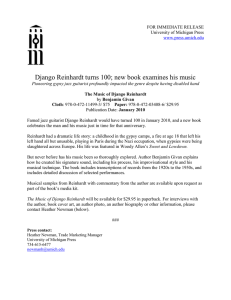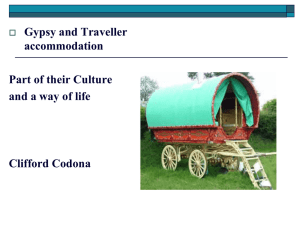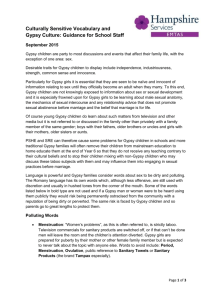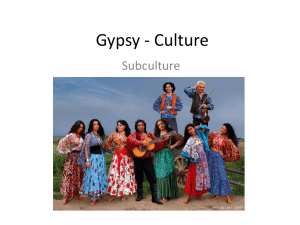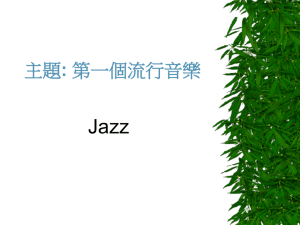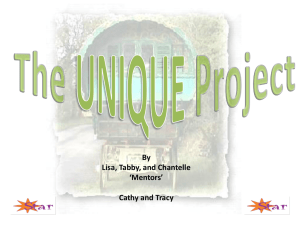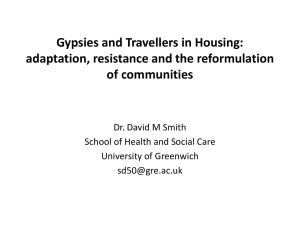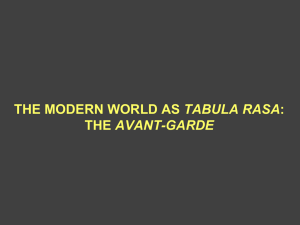Kiersten Kolstad - The Spirit of Great Oak
advertisement
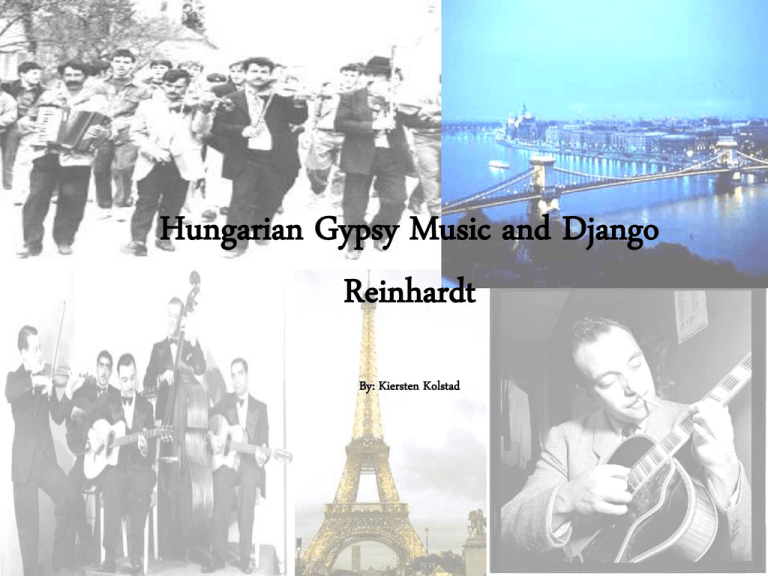
Hungarian Gypsy Music and Django Reinhardt By: Kiersten Kolstad Hungarian Demographics 35,919 square miles • Location: Eastern Europe • Population: 10,031,000 (2009) • Ethnicities: 94% Hungarian, 2% Roma/Gypsy, 2% German, 4% other. • Religion: 54% Catholic, 15% Protestant, 1% Jewish, and about 30% are atheist. Roma and Gypsy People • • • • • • The term "Gypsy" means anyone leading a nomadic life, but it usually refers to the Roma who are a traditionally nomadic people found throughout the world. The Roma share a common heritage that sets them apart as an ethnic group. Originally left from India as early as the 11th century. The Roma were persecuted throughout Europe in 15th century, especially in Hungary where they were forced into slavery. The various Romani tribes are divided into clans. Many Roma work as musicians and entertainers, and have had a strong influence in music. Musical tradition are still flourishing in Eastern Europe. Gypsy Music • • • • Primary instrument is the violin (which they put the most emphasis on), also fiddles, a bass, a cimbalom, accordions, and can contain vocals. string instruments incorporate prominent glissandos between notes and chromatic notes. Most commonly heard in small groups of 4-6 people playing in restaurants and on the streets. The scale that is used is the Hungarian Gypsy scale. It has an exotic sound and can be made by raising the 4th degree of a harmonic minor scale to introduce a gap or augmented second. Gypsy Music cont. • • • One instrument is primary focus at a time. Hungarian melodies are usually played in a strict succession: first the slow movements, the medium tempo “palotas” and then the fast “czardas” or the “faster friss czardas” Preference for diminished chords. Primary Instruments - Cimbalom and bass create the harmony - Cimbalom-player beats the rhythm with small hammers that shape the harmonies - In Gypsy music a traditional violin is used but Gypsy musicians usually chose violins with a dark tonal-quality from which they can create a unique sound • Djula & Tony - Friss Chardas Hungarian Gypsy Music http://www.youtube.com/watch?v=yPga4KzrVfg Django Reinhardt • • • • • • • • Was born as Jean Reinhardt on January 23, 1910 in Belgium. Reinhardt's nickname "Django" is Romani for "I awake. As a child he spent most of his youth in Romani encampments close to Paris. Played Banjo, Guitar, and Violin from an early age. At the age of 18, Reinhardt was injured in a fire and had badly injured his third and fourth finger of his left hand. Therefore he could only play with his pointer and index finger, and only used his other two fingers for chords. In 1934, Reinhardt and violinist Stephan Grappelli formed the “Quintette du Hot Club de France“ Reinhardt went to America and played and recorded with many American jazz musicians including Louis Armstrong. Still continued to compose music and wrote one of his most prominent pieces “Djangology” until his death on May 16, 1953 at age 43. Quintette du Hot Club de France • • • • • • Quintette du Hot Club de France was a Jazz group founded in France in 1934 by guitarist Django Reinhardt and violinist Stephan Grapelli. The group evolved from a series of backstage jams led by Django Reinhardt, with Stephane Grappelli, then bassist Louis Vola, and rhythm guitarists Roger Chaput and Joseph Reinhardt. the quintet created and popularized popularized the Gypsy Jazz style. When WWII broke out the band was on tour in the UK, Django returned to France while Grapelli stayed in the UK. Django continued using the Quintette name with a different group. This version of the Quintette did not issue many recordings, although they did issue the composition Nuages, later to become a jazz standard. Minor Swing Instruments • • • • One lead guitar Two rhythm guitars Bass fiddle Violin Django’s Guitar style and Gypsy Jazz • • • • • • Arpeggios: Django used a lot of arpeggios in his solos Chromatism: Chromatic notes are an important aspect of the gypsy sound and are used in many of his songs including Nuages, Honeysuckle Rose, J’attendrai and Minor Swing. Glissando: a slide that results in a rapid series of ascending or descending notes. String Bends The diminished sound: Hungarian Gypsy Scale: And in Gypsy Jazz… • The lead guitar (and violin) are played in a chromatic style with a heavy swing feel • The drum is replaced by 2 rhythm guitars that are played using a specific technique called “La Pompe". It’s a kind of strumming is done by playing a fast up-down strum followed by a down strum. Nuages Excerpt from one of his songs called Nuages played in the Hungarian gypsy scale: 1 2 b3 #4 5 b6 7 Comparison Similarities - Use string instruments for rhythm/beat of song - Utilize the Hungarian Gypsy Scale - Put emphasis on one instrument - Violin and Bass - Use the chromatic notes and Glissando’s -Consist of a small group of musicians. -Diminished chords Django Reinhardt -Use of acoustic guitars -Replaces drum and creates tempo through “la pompe” -Maintains consistent tempo Hungarian Gypsy music -Uses Cimbalom -Uses accordion -Cimbalom and bass sets the rhythm and harmony of piece -Changes tempo throughout the piece instead of staying at one steady one Works Cited • • • • • • • • • • • • • • • http://worldmusic.nationalgeographic.com/view/page.basic/genre/content.genre/roma__gypsy__music_778/en_US http://nigeldickinson.com/albums/gypsymusicdancebears/gypsy_music_dance01.jpg http://g.sheetmusicplus.com/Look-Inside/large/3150401_01.jpg http://en.wikipedia.org/wiki/Music_of_Hungary#Folk_music http://www.budapesthotels.com/touristguide/Music.asp http://www.answers.com/topic/django-reinhardt http://img1.photographersdirect.com/img/16876/wm/pd1796113.jpg http://www.youtube.com/watch?v=-iJ7bs4mTUY&feature=related http://images.encarta.msn.com/xrefmedia/sharemed/targets/images/pho/t166/T166655A.jpg http://en.wikipedia.org/wiki/Romani_music http://www.earth-photography.com/Countries/Hungary/Hungary_Budapest_Aerial0.html http://www.mnsu.edu/emuseum/cultural/oldworld/europe/gypsy.html http://en.wikipedia.org/wiki/Demographics_of_Hungary http://en.wikipedia.org/wiki/Gypsy_style http://www.jazzguitar.be/django_reinhardt.html • http://www.dicts.info/img/ud/double_bass.jpg
